battery PONTIAC GRAND-AM 1993 User Guide
[x] Cancel search | Manufacturer: PONTIAC, Model Year: 1993, Model line: GRAND-AM, Model: PONTIAC GRAND-AM 1993Pages: 306, PDF Size: 15.39 MB
Page 172 of 306
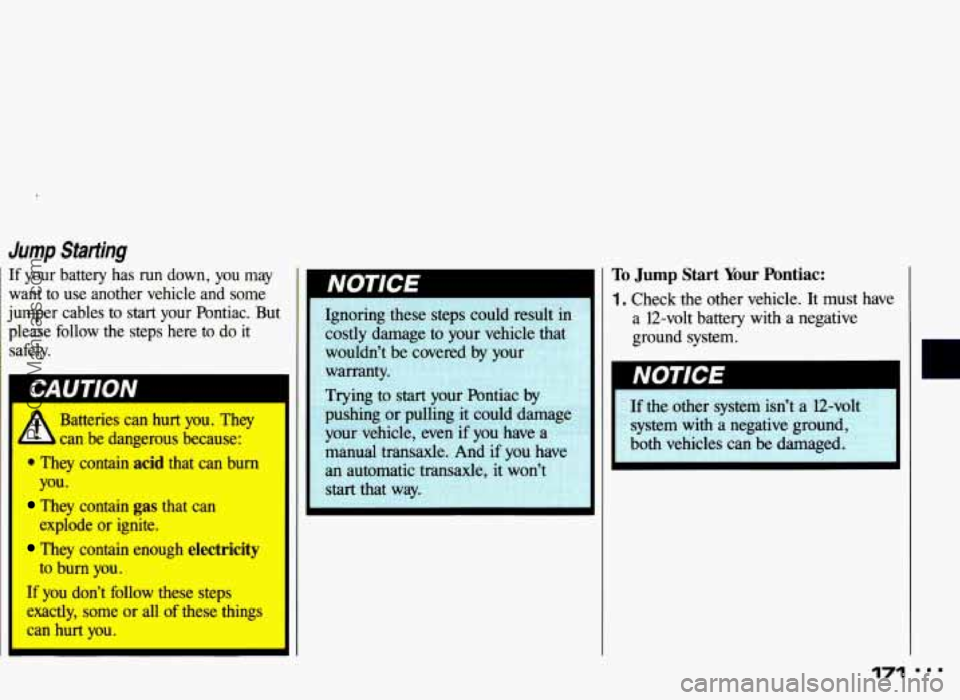
Jump Statting
If your battery has run down, you may
want to use another vehicle and some
jumper cables to
start your Pontiac. But
please follow the steps here to do it
safely.
Batteries can hurt you. They
. They contain acid that can burn
They contain gas that can
They contain enough electricity
If you don’t follow these steps
exactly, some
or all of these things
can hurt you.
- can be dangerous because:
you
*
explode or ignite.
to bum
you.
Ignoring these steps could result in
costly damage
to your vehicle that
wouldn’t be covered by your
warranty.
Trying to
start your Pontiac by
pushing or pulling it could damage
your vehicle, even if
you have a
manual transaxle. And if you have
an automatic transaxle, it won’t
start that way.
To Jump Start Your Pontiac:
1. Check the other vehicle. It must have
a 12-volt battery with
a negative
ground system.
If the other system isn’t a 12-volt
system
with a negative ground,
both vehicles can be damaged.
I
171
ProCarManuals.com
Page 173 of 306
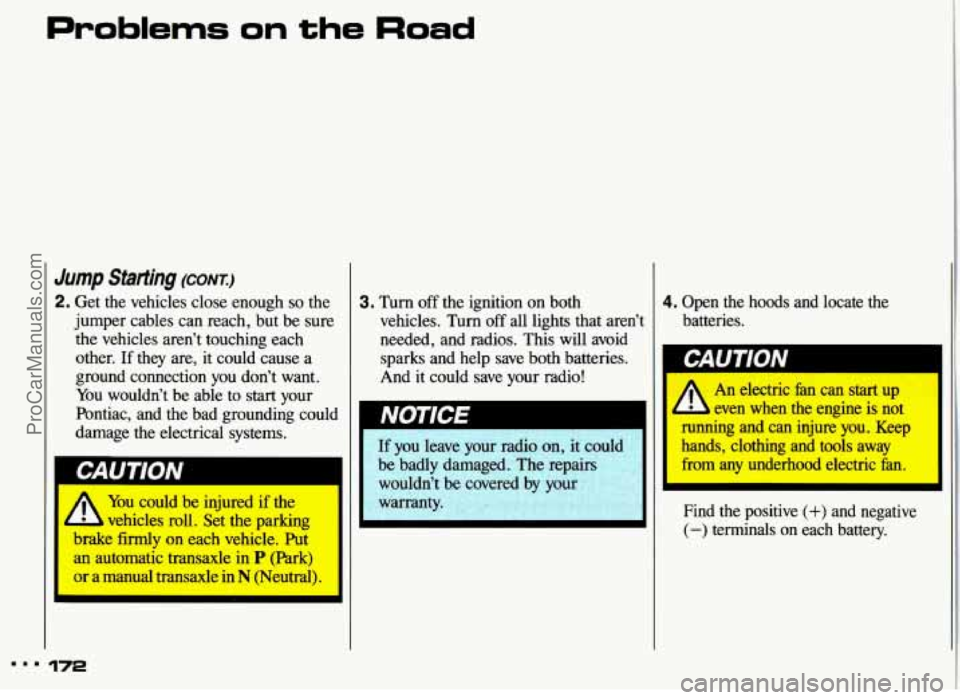
Jump Starting (CONTJ
2. Get the vehicles close enough so the
jumper cables can reach, but be sure
the vehicles aren’t touching each
other.
If they are, it could cause a
ground connection you don’t want.
You wouldn’t be able to
start your
Pontiac, and the bad grounding could
damage the electrical systems.
I; vehicles roll. Set the parking
brake
firmly on each vehicle. Put
an automatic transaxle in
P (Park)
or a manual transaxle in
N (Neutral). I I
3. Turn off the ignition on both
vehicles. Turn
off all lights that aren’t
needed, and radios.
This will avoid
sparks and help save both batteries.
And it could save your radio!
. 8. r ~
I If you leave your radio on, it could
4. Open the hoods and locate the batteries.
An electric fan can start up
e engine is not
running and can injure you. Keep
hands, clothing and tools away
from any underhood electric fan.
Find the positive (+) and negative
(-) terminals on each battery,
I.. 172
ProCarManuals.com
Page 174 of 306
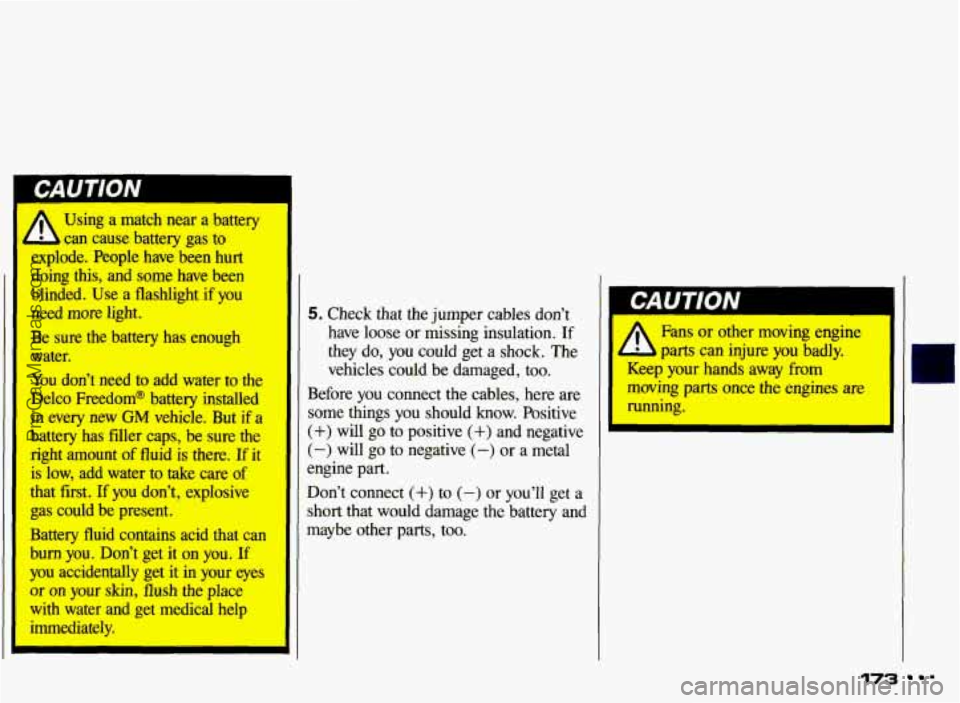
A
1 I water. Using
a match near
a battery
can cause battery
gas to
explode. ,People have been hurt
doing
this, and some have been
blinded.
Use a flashlight if you
need more light.
Be sure the battery has enough
You don’t need to add water to the
Delco Freedom@ battery installed
in every new GM vehicle. But if a
battery has fdler caps, be sure the
right amount of fluid is there.
If it
is low, add water to take care
of
that first. If you don’t, explosive
gas could be present.
Battery fluid contains acid that
can
burn you. Don’t get it on you. If
you accidentally get it in your eyes
or on your skin, flush the place
with water and get medical help
immediately.
1
5. Check that the jumper cables don’t
have loose or missing insulation.
If
they do, you could get a shock. The
vehicles could be damaged, too.
Before you connect the cables, here are
some things you should know. Positive
(+) will go to positive (+) and negative
(-) will go to negative (-) or a metal
engine part.
Don’t connect
(+) to (-) or you’ll get a
short that would damage the battery and
maybe other parts, too. Fans
or other moving engine
parts can injure you badly.
Keep your hands away from
moving parts once the engines are
running.
173 =
ProCarManuals.com
Page 175 of 306
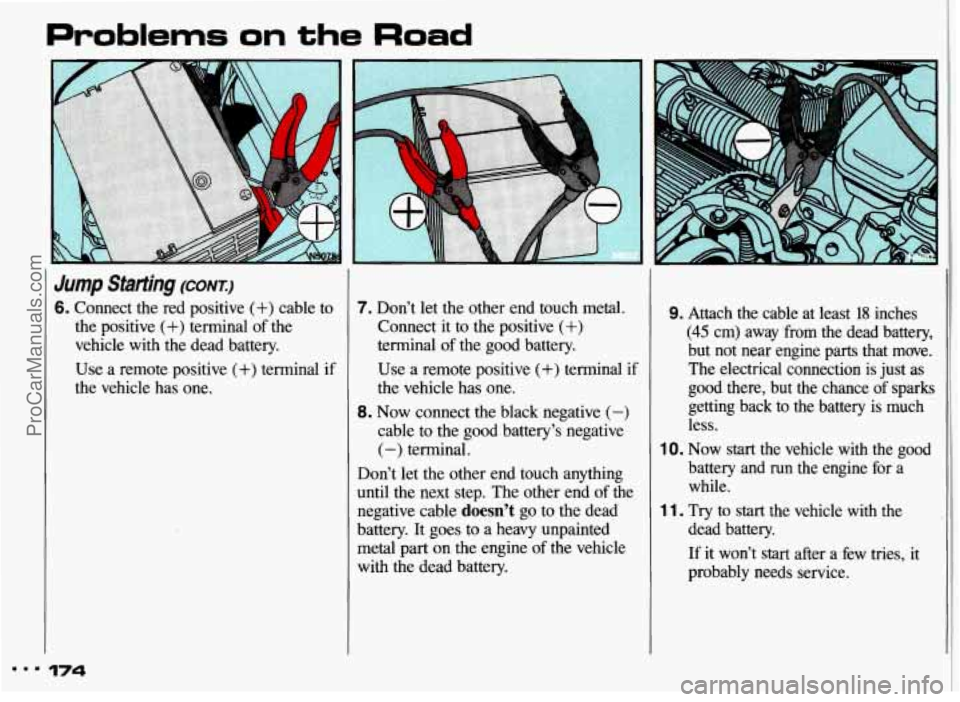
Problems on the Road
Jump Starting (CONI)
6. Connect the red positive (+) cable to
the positive
(+) terminal of the
vehicle with the dead battery.
Use a remote positive
(+) terminal if
the vehicle has one.
I74
7. Don’t let the other end touch metal.
Connect it to the positive
(+)
terminal of the good battery.
Use a remote positive
(+) terminal if
the vehicle has one.
8. Now connect the black negative (-)
cable to the good battery’s negative
(-) terminal.
Don’t let the other end touch anything
until the next step. The other end
of the
negative cable
doesn’t go to the dead
battery. It goes to a heavy unpainted
metal part on the engine of the vehicle
with the dead battery.
9. Attach the cable at least 18 inches
(45 cm) away from the dead battery,
but not near engine parts that move.
The electrical connection is just as
good there, but the chance
of sparks
getting back to the battery is much
less.
1 0. Now start the vehicle with the good
battery and run the engine for a
while.
11. Try to start the vehicle with the dead battery.
If it won’t
start after a few tries, it
probably needs service.
ProCarManuals.com
Page 198 of 306
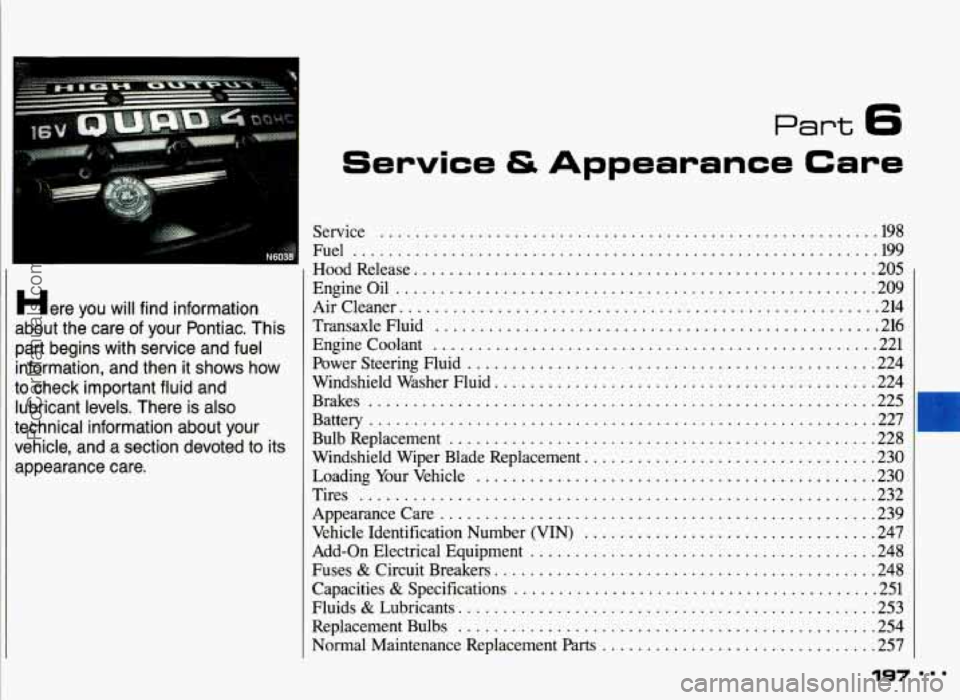
Part 6
... N604
Here you will find information
about the care of your Pontiac
. This
part begins with service and fuel
information. and then it shows how
to check important fluid and
lubricant levels
. There is also
technical information about your
vehicle. and a section devoted to its
appearance care
.
Service & Appearance Care
Service ................ .................................. 198
Fuel
........................................................... 199
HoodRelease .................................................... 205
Engineoil
...................................................... 209
Aircleaner
...................................................... 214
Transaxle Fluid
.................................................. 216
Engine Coolant
.................................................. 221
Power Steering Fluid
.............................................. 224
Windshield Washer Fluid
........................................... 224
Brakes
......................................................... 225
Battery
......................................................... 227
BulbReplacement
................................................ 228
Windshield Wiper Blade Replacement
................................. 230
Loading Your Vehicle
............................................. 230
Tires
.......................................................... 232
Appearancecare
................................................. 239
Vehicle Identification Number (VIN)
................................. 247
Add-on Electrical Equipment
....................................... 248
Fuses
& Circuit Breakers ........................................... 248
Capacities
& Specifications ......................................... 251
Fluids
& Lubricants ............................................... 253
Replacement Bulbs
............................................... 254
Normal Maintenance Replacement
Parts ............................. 257
197
ProCarManuals.com
Page 208 of 306
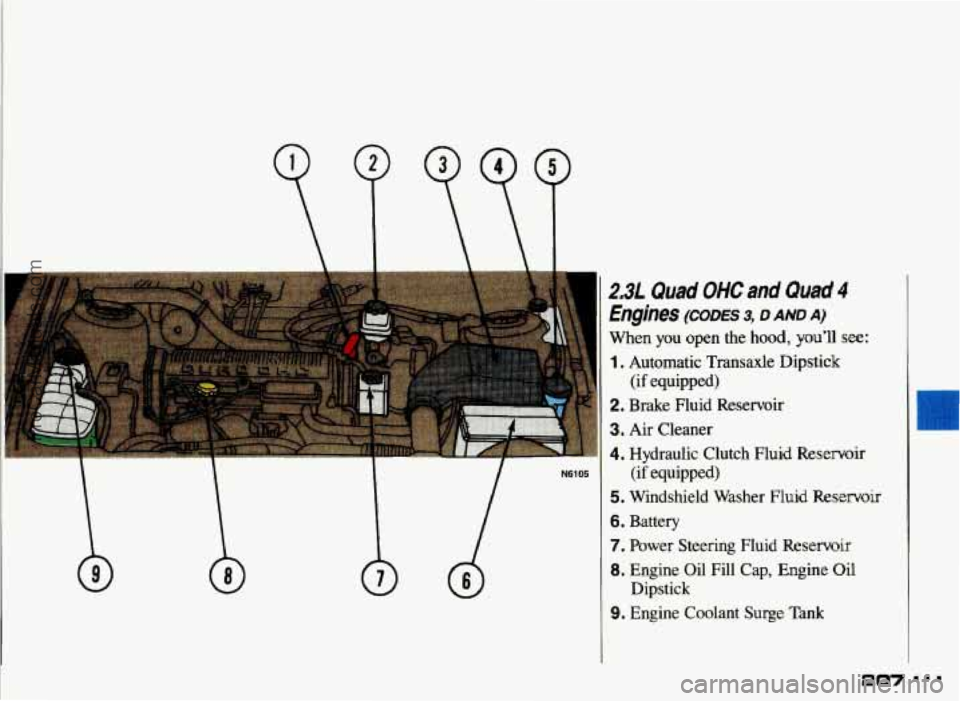
2.3L Quad OHC and Quad 4
Engines (CODES 3, D AND A)
When you open the hood, you'll see:
1 . Automatic Transaxle Dipstick
2. Brake Fluid Reservoir
3. Air Cleaner
4. Hydraulic Clutch Fluid Reservoir
5. Windshield Washer Fluid Reservoir
6. Battery
7. Power Steering Fluid Reservoir
8. Engine Oil Fill Cap, Engine Oil
9. Engine Coolant Surge Tank
(if equipped)
(if equipped)
Dipstick
ProCarManuals.com
Page 209 of 306
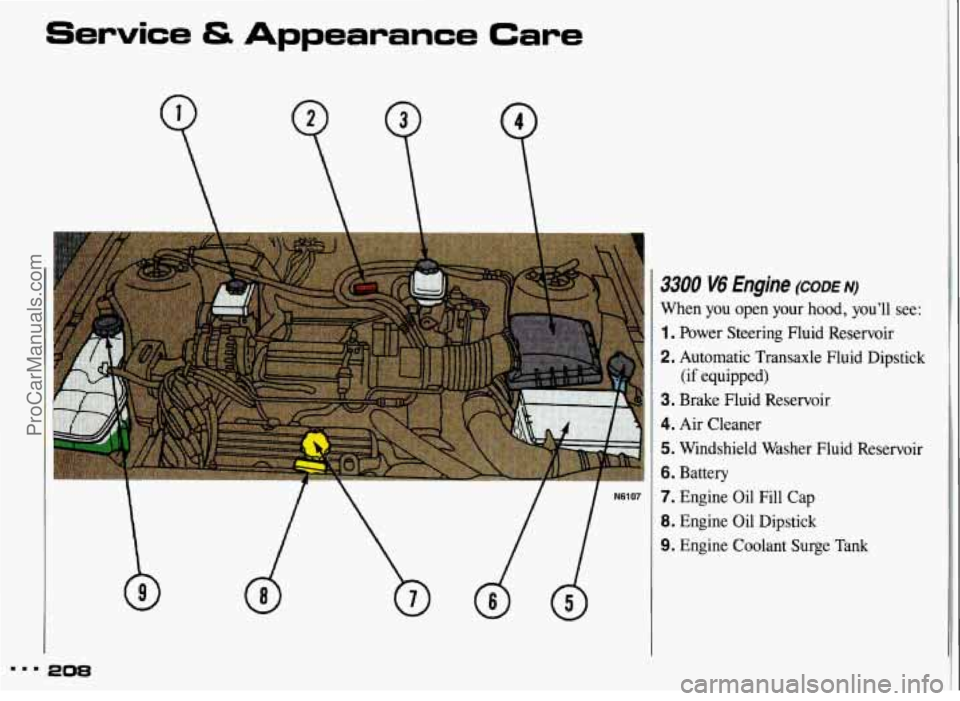
Service & Appearance Care
208
3300 V6 Engine (CODE N)
When you open your hood, you’ll see:
1. Power Steering Fluid Reservoir
2. Automatic Transaxle Fluid Dipstick
3. Brake Fluid Reservoir
4. Air Cleaner
5. Windshield Washer Fluid Reservoir
6. Battery
7. Engine Oil Fill Cap
8. Engine Oil Dipstick
9. Engine Coolant Surge Tank
(if equipped)
ProCarManuals.com
Page 228 of 306
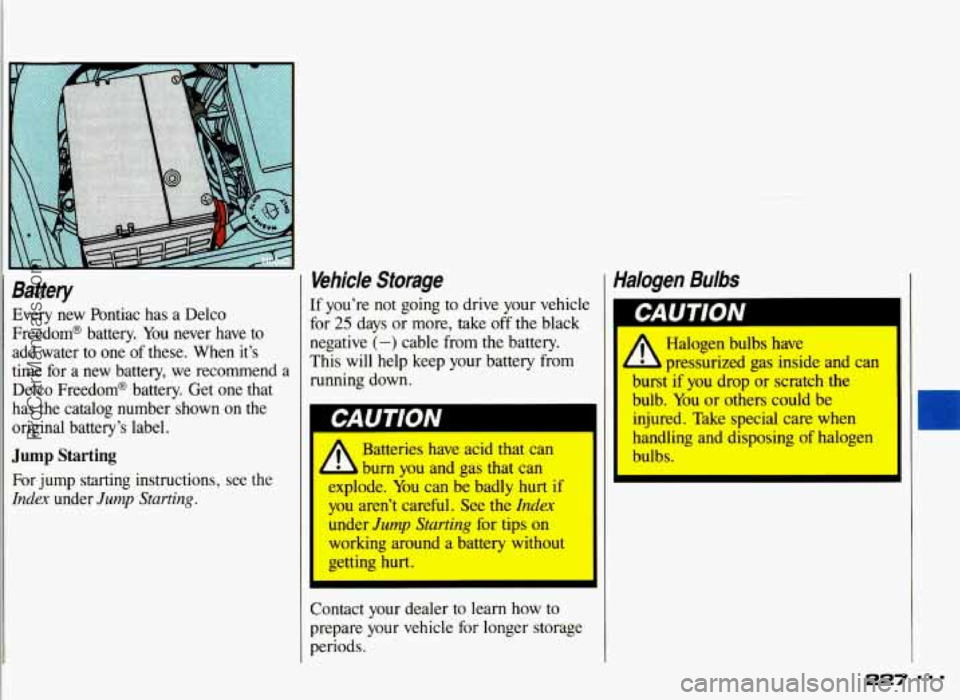
Battery
Every new Pontiac has a Delco
Freedom@ battery.
You never have to
add water to one of these. When it’s
time for a new battery,
we recommend a
Delco Freedom@ battery. Get one that
has the catalog number shown
on the
original battery’s label.
Jump
Starting
For jump starting instructions, see the
Index under Jump Starting.
Vehicle Storage
If you’re not going to drive your vehicle
for 25 days or more, take off the black
negative
(-) cable from the battery.
This will help keep your battery from
running down.
I
A
Batteries have acid that can
burn you and gas that can
explode.
You can be badly hurt if
you aren’t careful. See the Index
under Jump Starting for tips on
working around a battery without
getting hurt.
Contact your dealer to learn how to
prepare your vehicle for longer storage
periods.
Yalogen Bulbs
A Halogen bulbs have
burst if you drop or scratch the
bulb.
You or others could be
injured. Take special care when
handling and disposing of halogen
bulbs.
L pressurized gas inside and can
227
ProCarManuals.com
Page 294 of 306
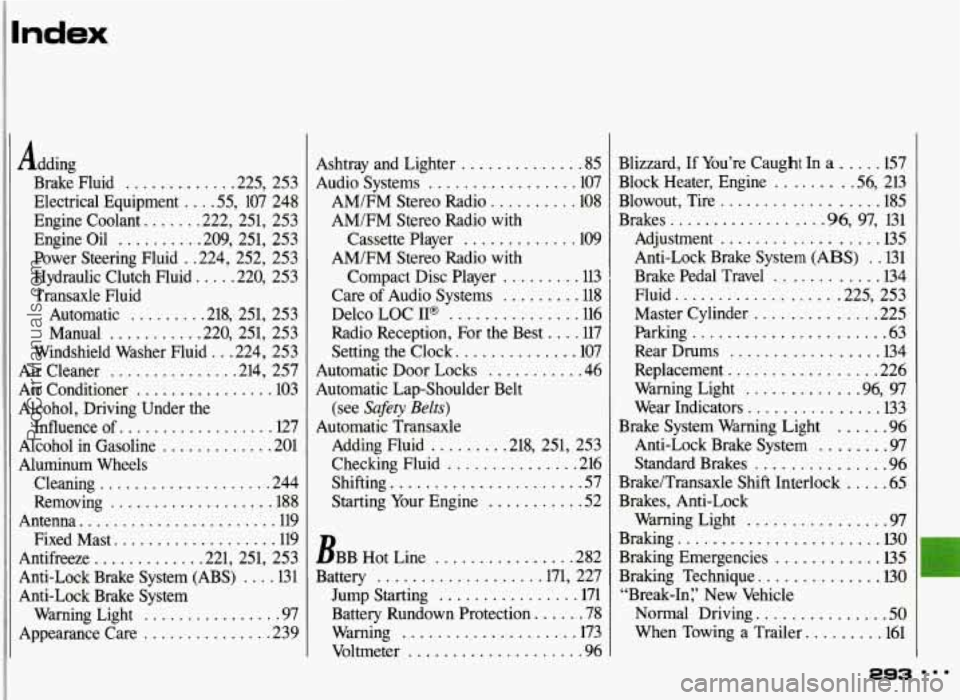
Adding Brake Fluid
............ .225. 253
Electrical Equipment
... .55. 107 248
Engine Coolant
...... .%22. 251. 253
Engine Oil
......... .209. 251. 253
Power Steering Fluid
. .224. 252. 253
Hydraulic Clutch Fluid
.... .220. 253
Transaxle Fluid Automatic
........ .218. 251. 253
Manual
.......... .220. 251. 253
Windshield Washer Fluid
.. .224. 253
Air Cleaner
.............. .214. 257
Air Conditioner
................ 103
Alcohol. Driving Under the
Influence of
.................. 127
Alcohol in Gasoline
............. 201
Aluminum Wheels
Cleaning
.................... 244
Removing
................... 188
Antenna
....................... 119
Fixed Mast
................... 119
Antifreeze
............ .221. 251. 253
Anti-Lock Brake System (ABS)
.... 131
Anti-Lock Brake System Warning Light
................ 97
Appearance Care
............... 239 Ashtray and Lighter
.............. 85
Audio Systems ................. 107
AM/FM Stereo Radio
.......... 108
AM/FM Stereo Radio with
Cassette Player
............. 109
AM/FM Stereo Radio with
Compact Disc Player
......... 113
Care
of Audio Systems ......... 118
Delco LOC
II@ ............... 116
Radio Reception. For the Best
.... 117
Setting the Clock
.............. 107
Automatic Door Locks
........... 46
Automatic Lap-Shoulder Belt
(see
Safety Belts)
Automatic Transaxle
Adding Fluid
........ .218, 251. 253
Checking Fluid
............... 216
Shifting
...................... 57
Starting Your Engine
........... 52
BBB Hot Line
................ 282
Battery
.................. .171. 227
Jump Starting
................ 171
Battery Rundown Protection
...... 78
Warning
.................... 173
Voltmeter
.................... 96
Blizzard. If You’re Caught In a ..... 157
Block Heater. Engine
........ .56. 213
Blowout. Tire
.................. 185
Brakes
................. .96. 97. 131
Adjustment
.................. 135
Anti-Lock Brake System (ABS)
. . 131
Brake Pedal Travel
............ 134
Fluid
.................. .225. 253
Master Cylinder
.............. 225
Parking
...................... 63
Rear Drums
................. 134
Replacement
................. 226
Warning Light
............ .96. 97
Wear Indicators
............... 133
Brake System Warning Light
...... 96
Standard Brakes ............... 96
Brake/Transaxle Shift Interlock ..... 65
Brakes. Anti-Lock Warning Light
................ 97
Braking
....................... 130
Braking Emergencies
............ 135
Braking Technique
.............. 130
“Break-In:’
New Vehicle
Normal Driving
............... 50
When Towing a Trailer ......... 161
Anti-Lock Brake System
........ 97
293
ProCarManuals.com
Page 296 of 306
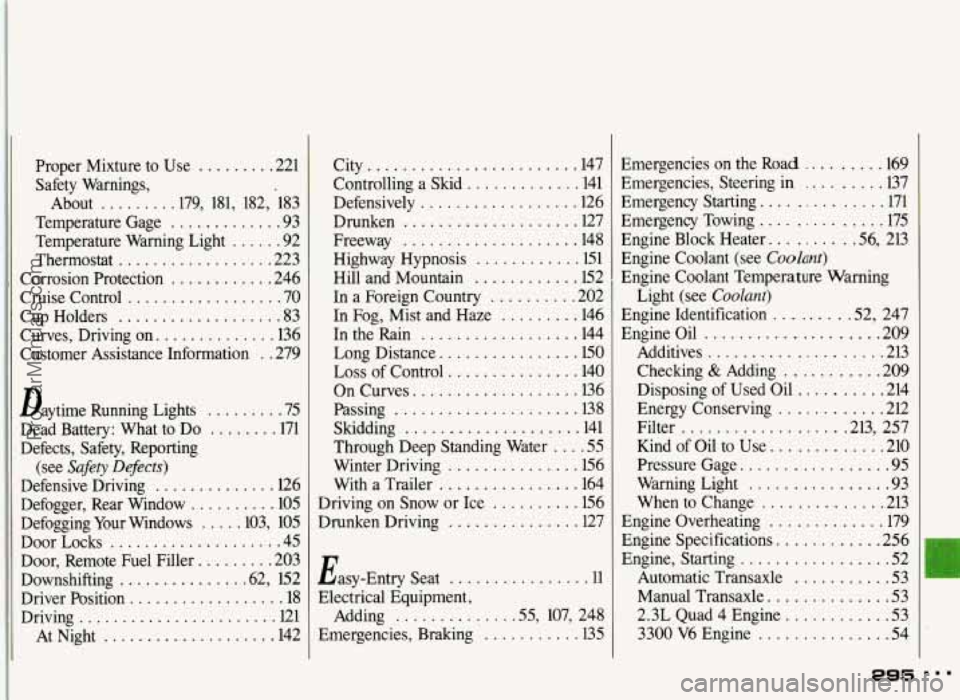
Proper Mixture to Use ......... 221
Safety Warnings. About
........ .179. 181. 182. 183
Temperature Gage
............. 93
Temperature Warning Light ...... 92
Thermostat
.................. 223
Corrosion Protection
............ 246
Cruise Control
.................. 70
Cup Holders
................... 83
Curves. Driving
on .............. 136
Customer Assistance Information
. . 279
Daytime Running Lights
......... 75
Defects. Safety. Reporting Dead Battery: What to Do
........ 171
Defensive Driving
.............. 126
(see
Safety Defects)
Defogger. Rear Window .......... 105
Defogging Your Windows
.... .103. 105
Door Locks
.................... 45
Door. Remote Fuel Filler
......... 203
Downshifting
.............. .62. 152
Driver Position
.................. 18
Driving
....................... 121
AtNight
.............. ... 142 City
........................ 147
Controlling a Skid
............. 141
Defensively
.................. 126
Drunken
.................... 127
Freeway
.................... 148
Highway Hypnosis
............ 151
Hill and Mountain
............ 152
In a Foreign Country
.......... 202
In Fog, Mist and Haze ......... 146
In the Rain
.................. 144
Long Distance ................ 150
Loss of Control
............... 140
On Curves ................... 136
Passing
..................... 138
Skidding
.................... 141
Through Deep Standing Water
.... 55
Winter Driving
............... 156
With a Trailer
................ 164
Driving on
Snow or Ice .......... 156
Drunken Driving
............... 127
Easy-Entry Seat
................ 11
Electrical Equipment, Adding
............. .55, 107, 248
Emergencies, Braking
........... 135 Emergencies
on the
Road ......... 169
Emergencies. Steering in
......... 137
Emergency Starting
.............. 171
Emergency Towing
.............. 175
Engine Block Heater
......... .56, 213
Engine Coolant (see
CooZant)
Engine Coolant Temperature Warning
Engine Identification
........ .52. 247
Engine Oil
.................... 209
Additives
.................... 213
Checking
& Adding ........... 209
Disposing of Used Oil
.......... 214
Energy Conserving
............ 212
Filter
.................. .213. 257
Kind of Oil to Use ............. 210
Pressure Gage
................. 95
Warning Light
................ 93
When to Change .............. 213
Engine Overheating
............. 179
Engine Specifications
............ 256
Engine. Starting
................. 52
Automatic Transaxle
........... 53
Manual Transaxle
.............. 53
2.3L Quad 4 Engine
............ 53
3300
V6 Engine ............... 54
295
Light (see Coolant)
ProCarManuals.com